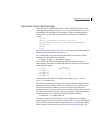
376 Configuring off-host processing
Implementing off-host processing solutions
8 On the primary host, if you temporarily suspended updates to a volume in
step 6, release all the database tables from hot backup mode.
9 On the primary host, deport the snapshot volume’s disk group using the
following command:
# vxdg deport snapvoldg
10 On the OHP host where the replica database is to be set up, use the following
command to import the snapshot volume’s disk group:
# vxdg import snapvoldg
11 The snapshot volume is initially disabled following the join. Use the
following command on the OHP host to recover and restart the snapshot
volume:
# vxrecover -g snapvoldg -m snapvol
12 On the OHP host, check and mount the snapshot volume. The following are
sample commands for checking and mounting a file system:
# fsck -F vxfs /dev/vx/rdsk/snapvoldg/snapvol
# mount -F vxfs /dev/vx/dsk/snapvoldg/snapvol \
mount_point
13 On the OHP host, use the appropriate database commands to recover and
start the replica database for its decision support role.
When you want to resynchronize the snapshot volume’ s data with the primary
database, you can reattach the snapshot volume to the original volume as
follows:
1 On the OHP host, shut down the replica database, and use the following
command to unmount the snapshot volume:
# umount mount_point
2 On the OHP host, use the following command to deport the snapshot
volume’s disk group:
# vxdg deport snapvoldg
3 On the primary host, re-import the snapshot volume’s disk group using the
following command:
# vxdg import snapvoldg
4 The snapshot volume is initially disabled following the join. Use the
following command on the primary host to recover and restart the snapshot
volume:
# vxrecover -g snapvoldg -m snapvol
5 On the primary host, reattach the snapshot volume to its original volume
using the following command:
# vxsnap -g snapvoldg reattach snapvol source=vol \
sourcedg=volumedg


















